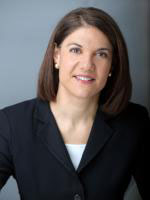Mary Ellen Iskenderian remembers the moment when she discovered her purpose in life.
As a child, her parents often took her to visit her father’s family in Turkey where she saw, for the first time, people living in utter poverty. She remembers thinking, “I don’t want to spend my life looking the other way.” She hasn’t. In 2006, she became president and CEO of New York City-based Women’s World Banking (WWB), a global network of 40 microfinance institutions (MFIs) and banks in 28 developing countries.
Committed to the “double bottom line” of financial returns and social progress, WWB offers credit, insurance and savings products that enable low-income women to build assets, guard against risk and provider better opportunities for their children. In the process, WWB enables its partners in microfinance to evolve from donor-dependent charities into self-sustaining financial institutions. “We know the poor can be economically savvy about juggling what little they have,” Iskenderian noted during a presentation at the 14th Annual Wharton Leadership Conference, whose theme was “Leading in a Recovering (and Even Rebounding) Economy.” “When someone trusts low-income women with capital, often for the first time, they can become agents of their own change.”
Mission Drift
In 2008, Women’s World Banking released a widely cited survey showing that if microfinance groups did not specifically target women, the percentage of female clients dropped sharply as the microfinance institutions evolved from donor-funded charities to regulated financial institutions. The phenomenon is called “mission drift,” and it occurs when organizations shift their focus toward higher-income (and supposedly less risky) clientele and away from low-income customers, which in many developing countries means women.
Iskenderian wants everyone to recognize the damage, unintended or not, caused by mission drift. Recently, a WWB publication uncovered another effect that hurts women: As organizations shift their focus to for-profit services, a marked decline occurs in the number of female staff members who might better understand the needs of women entrepreneurs.
The focus on mission drift among financial institutions comes at a time when a fierce worldwide debate is raging about microfinance and its future. In 2008, investors plowed $14.8 billion into microfinance, up 24% from the previous year. The microfinance industry now holds more than $60 billion in assets, according to The Center for Financial Inclusion. And, adds the World Bank, for the first time, most of the money in microfinance comes from private investors, including pension schemes and private equity funds, rather than governments. “There is definitely a risk of new shareholders switching microfinance institutions’ missions from alleviating poverty to chasing volumes and profits,” notes Maya Prabhu, head of philanthropy at the U.K. private bank Coutts & Co., who advises wealthy clients on investments in microfinance.
Falling into the ‘Red Zone’
Interest rates vary widely across the globe. But those that draw the most concern tend to occur in countries like Nigeria and Mexico, where the demand for small loans from a large population cannot be met by existing lenders, according to a recent article in The New York Times. The average interest rate in Mexico, for example, hovers around 70%, compared with a global average of roughly 37% in interest and fees. Mexican microfinance organizations can charge such rates because people are often so in need of cash that they will accept any terms offered to them. Occasionally, interest rates spark political intervention. In Nicaragua, President Daniel Ortega became outraged when rates began to reach 35% in 2008. He announced that he would back a microfinance institution that would charge 8% to 10%, using Venezuelan money.
Muhammad Yunus, a Bangladeshi banker and Nobel Peace Prize winner whom many experts regard as the founder of microfinance, has said that interest rates should be 10% to 15% above the cost of raising money, with anything beyond that range amounting to a “red zone” of loan sharking. Yet by that measure, 75% of microfinance institutions would fall into the red zone, according to a March 2010 analysis of 1,008 micro-lenders by the MIX, a website where more than 1,000 microfinance companies worldwide report their own numbers. Many experts label Yunus’s formula as overly simplistic and too low, and fear that a pronounced backlash against high interest rates will prompt lenders to retreat from the poorest customers.
Yunus is famous in the microfinance community for founding the Grameen Bank in his native Bangladesh. By 2006, the bank had disbursed more than $5.3 billion to borrowers, 96% of them groups of women. Yunus has said he decided to lend mainly to women because they were more responsible about repaying loans, and because families benefit more when women control the money.
The debate over microfinance and mission drift has intensified as some researchers maintain that there is more to developing an entrepreneur than providing credit. “Credit alone is not a panacea,” notes Jonathan Morduch, a professor of public policy and economics at New York University. “The boldest claim for microfinance — that it can single-handedly eliminate a large share of world poverty — outpaces, by a long distance, the evidence accumulated to date.” At the same time, however, analysts like Morduch emphasize the success of microfinance groups that combine lending with other initiatives, such as education and health care.
Charting a Path Forward
That model, as it turns out, is where Iskenderian is pushing WWB to go.
To put its stamp on what Iskenderian calls “the next 30 years” of microfinance, WWB is moving into a broad array of products and services for women, including savings, insurance and financial education. “Loans and credit was the model for the first 30 years of microfinance,” she stated. “Savings is the future, the missing piece in climbing out of poverty.” Currently, WWB is sponsoring research on the use of mobile phone technology and ATMs as ways to provide low-income women with banking services.
“It’s not always size that makes the difference in [microfinance],” Iskenderian said. “People make the difference with their energy and their resolve…. Single individuals and the choices they make have a tremendous impact on the world.”



